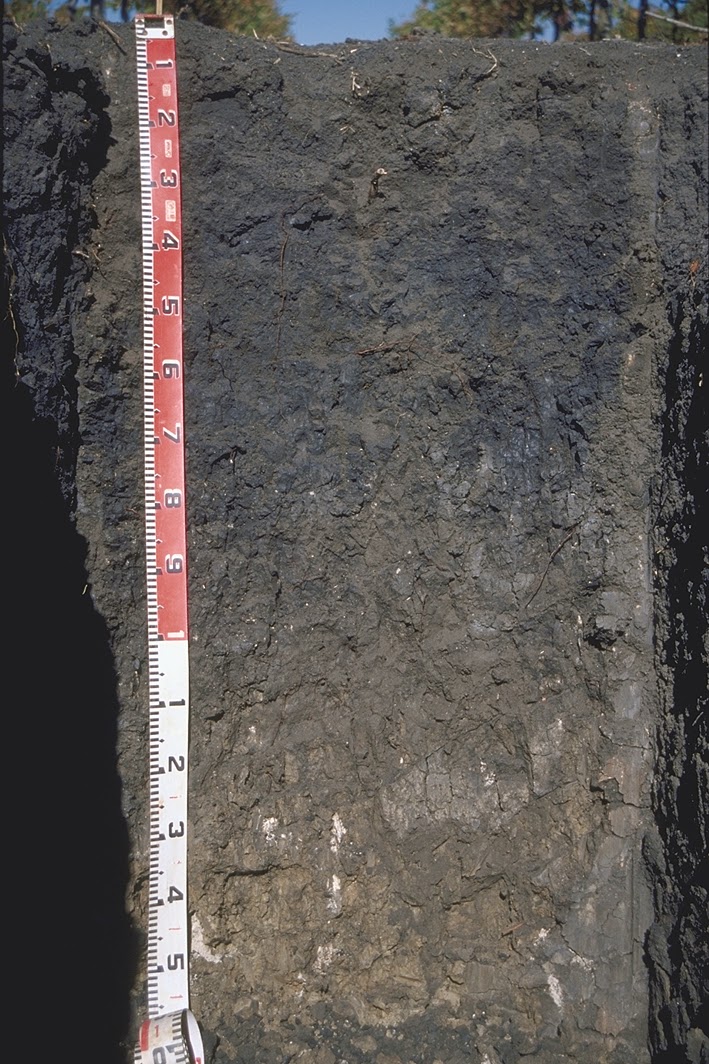Sand (11% of the McLaren Vale Wine Region - mainly located in Blewitt Springs and McLaren Flat)
PIC: Sandy soil with clay and gravel at 1.0 metres depth. Did you know? Sandy soils generally have clay/gravel underneath, sometimes this is at greater than 3 m depth, and often vineyards on the tops of hills have more vigour than those at the bottom!
NOTES:
Topsoil: sandy with a gravelly and bleached horizon.
Subsoil: yellow and red sandy clay loam to clay.
Drainage: well drained but seepage can occur in the gravel layer above the clay, creating a subsoil waterlogging problem.
Natural fertility: Low. Cation capacity is low. Organic carbon is often very low.
Salinity and sodicity issues: generally not an issue but localised salinity can be introduced by seepage water.
Black Heavy Clay - "Bay of Biscay" (7% of the McLaren Vale Wine Region)
PIC: Heavy black, cracking Biscay Clay.
NOTES:
Topsoil: black cracking clay (sometimes self-mulching) with increasing amounts of soft carbonate.
Subsoil: black clay grading to grey-green heavy clay.
Drainage: imperfect and leaching of salts can be an issue.
Natural fertility: deep and inherently fertile but difficult to work, especially when wet.
Salinity and sodicity issues: are possible in these soils with some naturally saline and/or sodic. Irrigating with marginal water can make these problems worse.
Other: boron toxicity problems are possible in these soils.
Loam over red clay - "Urrbrae Loam" (26% of the McLaren Vale Wine Region)
PIC: The famous Urrbrae soil.
Topsoil: silty loam to silty clay loam.
Subsoil: red clay with increasing soft carbonate at depth.
Drainage: moderately well drained.
Natural fertility: deep and inherently fertile.
Salinity and sodicity issues: soils are generally not naturally saline or sodic but problems can occur due to the accumulation of salt from irrigation water. Often vineyards with these soils are irrigated with bore water.
Other: Main limitations are related to poor structure due to the high silt content of the surface soils and susceptibility of the upper part of the profile to compaction. These soils compact with repeated tractor driving.
“Terra Rossa” like soil (20% of the McLaren Vale Wine Region)
PIC: Terra rossa (means red soil in italian) soils occur many areas of the world. Compared to most clayey soils, terra rossa has good drainage characteristics. This makes it a popular soil type for food and wine production. Among other wine regions, it is found in La Mancha in Spain and the Coonawarra locally.
Topsoil: clay loam increasing clay content.
Subsoil: highly calcareous clay loam to clay.
Drainage: well drained.
Natural fertility: moderate to high fertility.
Salinity and sodicity issues: SImilar to Urrbrae soil, salinity or sodicity problems can occur due to the accumulation of salt from irrigation water.
Sandy loam over brown clay - "Gilgai" (24% of the McLaren Vale Wine Region)
PIC: Soil from near Rifle Range rd, between Willunga and McLaren Vale.
Topsoil: grey massive sandy loam grading to bleached loamy sand.
Subsoil: brown mottled poorly structured clay with soft carbonate at depth.
Drainage: imperfectly drained.
Natural fertility: shallow with moderate fertility.
Salinity and sodicity issues: soils are not naturally saline but due to the poor drainage and sodic nature of the clay, salts can accumulate in the top clay layers and cause salinity issues.
Other: Water can perch on the poorly structured subsoil clay saturating the upper profile for up to several weeks after prolonged rain.
NOTES BY JAMES HOOK - DJ's





